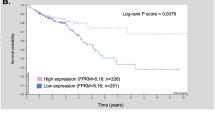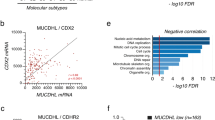Abstract
Defects in the adenomatous polyposis coli (APC) tumor suppressor pathway are sufficient for neoplastic transformation as the initiating step in colorectal carcinogenesis. In contrast, hyperplastic tumors possess normal APC function, and it is unclear whether they represent significant precursor lesion in cancer development. CEACAM1 is a tumor suppressor whose expression is known to be lost in the great majority of early adenomas and carcinomas. We found that loss of CEACAM1 expression is more common in neoplastic tumors than APC mutations. While APC function was normal in hyperplastic aberrant cypt foci and hyperplastic polyps, loss of CEACAM1 was observed as frequently as in the neoplasias. Moreover, the presence or absence of CEACAM1 expression in the hyperplastic tumors correlates with normal or reduced apoptosis, respectively. In vitro, CEACAM1 acts as a regulator of apoptosis in CEACAM1-transfected Jurkat cells. Finally, in human HT29 colon cancer cells, apoptosis can be specifically restored by induction of CEACAM1 expression. These data suggest an oncodevelopmental link between neoplasia and hyperplasia and demonstrate that CEACAM1 acts as a regulator of apoptosis in the colonic epithelium. Thus, failure of the maturing colon cell to express CEACAM1 is likely to contribute to the development of hyperplastic lesions, which may eventually pave the way to neoplastic transformation and colon cancer development.
This is a preview of subscription content, access via your institution
Access options
Subscribe to this journal
Receive 50 print issues and online access
$259.00 per year
only $5.18 per issue
Buy this article
- Purchase on Springer Link
- Instant access to full article PDF
Prices may be subject to local taxes which are calculated during checkout







Similar content being viewed by others
Abbreviations
- ACF:
-
aberrant crypt foci
- APC:
-
gene for adenomatous polyposis coli
- CEACAM:
-
CEA-like cell adhesion molecule
- HP:
-
hyperplastic polyp
- PTT:
-
protein truncation test
References
Avizienyte E, Loukola A, Roth S, Hemminki A, Tarkkanen M, Salovaara R, Arola J, Butzow R, Husgafvel-Pursiainen K, Kokkola A, Jarvinen H and Aaltonen LA . (1999). Am. J. Pathol., 154, 677–681.
Baas AF, Kuipers J, van der Wel NN, Batlle E, Koerten HK, Peters PJ and Clevers HC . (2004). Cell, 116, 457–466.
Bala S, Kraus C, Wijnen J, Meera Khan P and Ballhausen WG . (1996). Hum. Genet., 98, 528–533.
Battu S, Rigaud M and Beneytout JL . (1998). Anticancer Res., 18, 3579–3583.
Beauchemin N, Draber P, Dveksler G, Gold P, Gray-Owen S, Grunert F, Hammarstrom S, Holmes KV, Karlsson A, Kuroki M, Lin SH, Lucka L, Najjar SM, Neumaier M, Obrink B, Shively JE, Skubitz KM, Stanners CP, Thomas P, Thompson JA, Virji M, von Kleist S, Wagener C, Watt S and Zimmermann W . (1999). Exp. Cell Res., 252, 243–249.
Bird RP . (1987). Cancer Lett., 37, 147–151.
Bird RP . (1995). Cancer Lett., 93, 55–71.
Blau DM, Turbide C, Tremblay M, Olson M, Letourneau S, Michaliszyn E, Jothy S, Holmes KV and Beauchemin N . (2001). J. Virol., 75, 8173–8186.
Brummer J, Neumaier M, Gopfert C and Wagener C . (1995). Oncogene, 11, 1649–1655.
Esteller M, Sparks A, Toyota M, Sanchez-Cespedes M, Capella G, Peinado MA, Gonzalez S, Tarafa G, Sidransky D, Meltzer SJ, Baylin SB and Herman JG . (2000). Cancer Res., 60, 4366–4371.
Fearnhead NS, Britton MP and Bodmer WF . (2001). Hum. Mol. Genet., 10, 721–733.
Fearon ER and Vogelstein B . (1990). Cell, 61, 759–769.
Fournes B, Sadekova S, Turbide C, Letourneau S and Beauchemin N . (2001). Oncogene, 20, 219–230.
Frangsmyr L, Baranov V, Prall F, Yeung MM, Wagener C and Hammarstrom S . (1995). Cancer Res., 55, 2963–2967.
Goss KH and Groden J . (2000). J. Clin. Oncol., 18, 1967–1979.
Hammarstrom S . (1999). Semin. Cancer Biol., 9, 67–81.
Hawkins NJ, Gorman P, Tomlinson IP, Bullpitt P and Ward RL . (2000). Am. J. Pathol., 157, 385–392.
Hawkins NJ and Ward RL . (2001). J. Natl. Cancer Inst., 93, 1307–1313.
Herter P, Kuhnen C, Muller KM, Wittinghofer A and Muller O . (1999). J. Cancer Res. Clin. Oncol., 125, 297–304.
Izzi L, Turbide C, Houde C, Kunath T and Beauchemin N . (1999). Oncogene, 18, 5563–5572.
Jass JR . (2001). Dis. Colon Rectum, 44, 163–166.
Jass JR, Iino H, Ruszkiewicz A, Painter D, Solomon MJ, Koorey DJ, Cohn D, Furlong KL, Walsh MD, Palazzo J, Edmonston TB, Fishel R, Young J and Leggett BA . (2000). Gut, 47, 43–49.
Jen J, Powell SM, Papadopoulos N, Smith KJ, Hamilton SR, Vogelstein B and Kinzler KW . (1994). Cancer Res., 54, 5523–5526.
Kikuchi Y, Dinjens WN and Bosman FT . (1997). Virchows Arch., 431, 111–117.
Kinzler KW and Vogelstein B . (1996). Cell, 87, 159–170.
Kirchgesser M, Albers A, Vossen R, den Dunnen J, van Ommen GJ, Gebert J, Dupont C, Herfarth C, von Knebel-Doeberitz M and Schmitz-Agheguian G . (1998). Clin. Chem. Lab. Med., 36, 567–570.
Kirshner J, Chen CJ, Liu P, Huang J and Shively JE . (2003). Proc. Natl. Acad. Sci. USA, 100, 521–526.
Kunath T, Ordonez-Garcia C, Turbide C and Beauchemin N . (1995). Oncogene, 11, 2375–2382.
Launonen V, Avizienyte E, Loukola A, Laiho P, Salovaara R, Jarvinen H, Mecklin JP, Oku A, Shimane M, Kim HC, Kim JC, Nezu J and Aaltonen LA . (2000). Cancer Res., 60, 546–548.
Laurent-Puig P, Blons H and Cugnenc PH . (1999). Eur. J. Cancer Prev., 8, S39–S47.
Michor F, Iwasa Y, Rajagopalan H, Lengauer C and Nowak MA . (2004). Cell Cycle, 3, 358–362, Epub 2004 March.
Mori H, Yamada Y, Kuno T and Hirose Y . (2004). Mutat. Res., 566, 191–208.
Nap M, Hammarstrom ML, Bormer O, Hammarstrom S, Wagener C, Handt S, Schreyer M, Mach JP, Buchegger F, von Kleist S, Grunert F, Seguin P, Fuks A, Holm R and Lamerz R . (1992). Cancer Res., 52, 2329–2339.
Neumaier M, Paululat S, Chan A, Matthaes P and Wagener C . (1993). Proc. Natl. Acad. Sci. USA, 90, 10744–10748.
Nollau P, Prall F, Helmchen U, Wagener C and Neumaier M . (1997a). Am. J. Pathol., 151, 521–530.
Nollau P, Scheller H, Kona-Horstmann M, Rohde S, Hagenmuller F, Wagener C and Neumaier M . (1997b). Cancer Res., 57, 2354–2357.
Otori K, Konishi M, Sugiyama K, Hasebe T, Shimoda T, Kikuchi-Yanoshita R, Mukai K, Fukushima S, Miyaki M and Esumi H . (1998). Cancer, 83, 896–900.
Otori K, Sugiyama K, Hasebe T, Fukushima S and Esumi H . (1995). Cancer Res., 55, 4743–4746.
Powell SM, Petersen GM, Krush AJ, Booker S, Jen J, Giardiello FM, Hamilton SR, Vogelstein B and Kinzler KW . (1993). N. Engl. J. Med., 329, 1982–1987.
Powell SM, Zilz N, Beazer-Barclay Y, Bryan TM, Hamilton SR, Thibodeau SN, Vogelstein B and Kinzler KW . (1992). Nature, 359, 235–237.
Robitaille J, Izzi L, Daniels E, Zelus B, Holmes KV and Beauchemin N . (1999). Eur. J. Biochem., 264, 534–544.
Roncucci L, Pedroni M, Vaccina F, Benatti P, Marzona L and De Pol A . (2000). Cell Prolif., 33, 1–18.
Rowan AJ, Lamlum H, Ilyas M, Wheeler J, Straub J, Papadopoulou A, Bicknell D, Bodmer WF and Tomlinson IP . (2000). Proc. Natl. Acad. Sci. USA, 97, 3352–3357.
Sambrook J, Fritsch EF and Maniatis T . (1989). Molecular Cloning: A Laboratory Manual 2nd edn. Cold Spring Harbor Laboratory Press: Cold Spring Harbor, NY.
Shih IM, Wang TL, Traverso G, Romans K, Hamilton SR, Ben-Sasson S, Kinzler KW and Vogelstein B . (2001). Proc. Natl. Acad. Sci. USA, 98, 2640–2645.
Shpitz B, Hay K, Medline A, Bruce WR, Bull SB, Gallinger S and Stern H . (1996). Dis. Colon Rectum, 39, 763–767.
Singer BB, Scheffrahn I, Heymann R, Sigmundsson K, Kammerer R and Obrink B . (2002). J. Immunol., 168, 5139–5146.
Smith AJ, Stern HS, Penner M, Hay K, Mitri A, Bapat BV and Gallinger S . (1994). Cancer Res., 54, 5527–5530.
Suzuki H, Watkins DN, Jair KW, Schuebel KE, Markowitz SD, Dong Chen W, Pretlow TP, Yang B, Akiyama Y, Van Engeland M, Toyota M, Tokino T, Hinoda Y, Imai K, Herman JG and Baylin SB . (2004). Nat. Genet., 36, 417–422.
Takahashi H, Okai Y, Paxton RJ, Hefta LJ and Shively JE . (1993). Cancer Res., 53, 1612–1619.
Tan S, Seow TK, Liang RC, Koh S, Lee CP, Chung MC and Hooi SC . (2002). Int. J. Cancer, 98, 523–531.
Turbide C, Kunath T, Daniels E and Beauchemin N . (1997). Cancer Res., 57, 2781–2788.
Wynter CV, Walsh MD, Higuchi T, Leggett BA, Young J and Jass JR . (2004). Gut, 53, 573–580.
Zhang L, Zhou W, Velculescu VE, Kern SE, Hruban RH, Hamilton SR, Vogelstein B and Kinzler KW . (1997). Science, 276, 1268–1272.
Acknowledgements
We are grateful to Bert Vogelstein for critical reading of the manuscript and his helpful advice. We thank John E Shively for the generous gift of CEACAM1-transfected Jurkat cells and Christoph Wagener for supplying mab 4D1C2. MN was supported in part by the German Research Council Grant Ne677/2.
Author information
Authors and Affiliations
Corresponding author
Rights and permissions
About this article
Cite this article
Nittka, S., Günther, J., Ebisch, C. et al. The human tumor suppressor CEACAM1 modulates apoptosis and is implicated in early colorectal tumorigenesis. Oncogene 23, 9306–9313 (2004). https://doi.org/10.1038/sj.onc.1208259
Received:
Revised:
Accepted:
Published:
Issue Date:
DOI: https://doi.org/10.1038/sj.onc.1208259
Keywords
This article is cited by
-
Structural basis of the dynamic human CEACAM1 monomer-dimer equilibrium
Communications Biology (2021)
-
Tumor intrinsic immunity related proteins may be novel tumor suppressors in some types of cancer
Scientific Reports (2019)
-
Correlation between immunohistochemical staining of CEACAM1 and clinicopathological findings in oral pre-neoplastic lesions and squamous cell carcinoma
Medical Molecular Morphology (2018)
-
Loss of CEACAM1, a Tumor-Associated Factor, Attenuates Post-infarction Cardiac Remodeling by Inhibiting Apoptosis
Scientific Reports (2016)
-
Roles of CEACAM1 in cell communication and signaling of lung cancer and other diseases
Cancer and Metastasis Reviews (2015)



